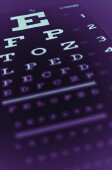High sensitivity and specificity for Jaeb Visual Acuity Screener for 3- to 7-year-old children
MONDAY, May 4, 2015 (HealthDay News) — A computerized visual acuity-based screening program that employs a rapid, age-specific standardized algorithm is effective and practical for screening 3- to 7-year-old children, according to a study published in the April issue of the Journal of the American Association for Pediatric Ophthalmology and Strabismus.
Tomohiko Yamada, O.D., from the Mayo Clinic in Rochester, Minn., and colleagues developed and validated the Jaeb Visual Acuity Screener (JVAS) for vision screening in the medical home. One hundred seventy-five children aged 3 to younger than 8 years were screened with the JVAS and then underwent a complete eye examination (gold standard). Two large single surround optotypes were presented by the JVAS and then five optotypes were presented at a predetermined, age-specific normal threshold. The sensitivity and specificity of the JVAS for detecting reduced visual acuity, amblyopia, and amblyopia risk factors was assessed.
The researchers found that there was high screening testability for the JVAS (100 percent). Sensitivity and specificity of the JVAS ranged from 88 to 91 percent and from 73 to 86 percent, respectively. Positive predictive values ranged from 66 to 79 percent, and negative predictive values varied from 92 to 93 percent.
“The new JVAS provides an effective and practical method for screening 3- to 7-year-olds using any Windows-based computer,” the authors write. “Providing the JVAS free-of-charge to pediatricians and school systems would standardize currently fragmented visual acuity-based screening practices.”
Copyright © 2015 HealthDay. All rights reserved.








